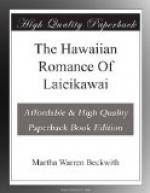Says the boy, “You full-grown men have found so many uses, you whose teeth are rotten with age, why can’t I, a lad, find other uses, to save myself so that I may live. I shall search for some more hau, and if I fail you shall live, but if I find them you shall surely die.”
“Aina hau kinikini o Kona,
Na’u i helu hookahi hau,
A ehiku hau keu.
O Honolohau la akahi,
O Lanihau la alua
O Punohau la akolu,
O Kahauloa la aha,
O Auhaukea la alima,
O Kahauiki la aono,
Holo kehau i ka waa kona la ahiku.”
A land of many hau trees
is in Kona
Out of a single hau I have
counted one,
And found seven hau.
Honolahau makes one,
Lanihau makes two,
Punohau makes three,
Kahauloa makes four,
Auhaukea makes five,
Kahaniki makes six,
The Kehau that drives the canoe
at Kona makes seven.
(All names of places in the Kona district.)
“There are seven hau, you men with rotten teeth.”]
[Footnote 5: Thomson says that the Fijians differ from the Polynesians in their indifference to beauty in nature.]
3. ANALOGY: ITS PICTORIAL QUALITY
A second significant trait in the treatment of objective life, swiftness of analogy, affects the Polynesian in two ways: the first is pictorial and plays upon a likeness between objects or describes an idea or mood in metaphorical terms; the second is a mere linguistic play upon words. Much nomenclature is merely a quick picturing which fastens attention upon the special feature that attracts attention; ideas are naturally reinforced by some simple analogy. I recall a curious imported flower with twisted inner tube which the natives call, with a characteristic touch of daring drollery, “the intestines of the clergyman.” Spanish moss is named from a prominent figure of the foreign community “Judge Dole’s beard.” Some native girls, braiding fern wreaths, called my attention to the dark, graceful fronds which grow in the shade and are prized for such work. “These are the natives,” they said; then pointing slyly to the coarse, light ferns burned in the sun they added, “these are the foreigners.” After the closing exercises of a mission school in Hawaii one of the parents was called upon to make an address. He said: “As I listen to the songs and recitations I am like one who walks through the forest where the birds are singing. I do not understand the words, but the sound is sweet to the ear.” The boys in a certain district school on Hawaii call the weekly head inspection “playing the ukulele” in allusion to the literal interpretation of the name for the native banjo. These homely illustrations, taken from the everyday life of the people, illustrate a habit of mind which, when applied for conscious emotional effect, results in much charm of formal expression. The habit of isolating the essential feature leads




